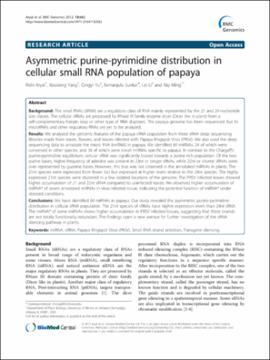| dc.contributor.author | Aryal, Rishi | |
| dc.contributor.author | Yang, Xiaozeng | |
| dc.contributor.author | Yu, Qingyi | |
| dc.contributor.author | Sunkar, Ramanjulu | |
| dc.contributor.author | Li, Lei | |
| dc.contributor.author | Ming, Ray | |
| dc.date.accessioned | 2018-11-09T21:10:45Z | |
| dc.date.available | 2018-11-09T21:10:45Z | |
| dc.date.issued | 2012-12-05 | |
| dc.identifier | oksd_aryal_asymmetricpurin_2012 | |
| dc.identifier.citation | Aryal, R., Yang, X., Yu, Q., Sunkar, R., Li, L., & Ming, R. (2012). Asymmetric purine-pyrimidine distribution in cellular small RNA population of papaya. BMC Genomics, 13, Article 682. https://doi.org/10.1186/1471-2164-13-682 | |
| dc.identifier.uri | https://hdl.handle.net/11244/302050 | |
| dc.description.abstract | Background: The small RNAs (sRNA) are a regulatory class of RNA mainly represented by the 21 and 24-nucleotide size classes. The cellular sRNAs are processed by RNase III family enzyme dicer (Dicer like in plant) from a self-complementary hairpin loop or other type of RNA duplexes. The papaya genome has been sequenced, but its microRNAs and other regulatory RNAs are yet to be analyzed. | |
| dc.description.abstract | Results: We analyzed the genomic features of the papaya sRNA population from three sRNA deep sequencing libraries made from leaves, flowers, and leaves infected with Papaya Ringspot Virus (PRSV). We also used the deep sequencing data to annotate the micro RNA (miRNA) in papaya. We identified 60 miRNAs, 24 of which were conserved in other species, and 36 of which were novel miRNAs specific to papaya. In contrast to the Chargaff's purine-pyrimidine equilibrium, cellular sRNA was significantly biased towards a purine rich population. Of the two purine bases, higher frequency of adenine was present in 23nt or longer sRNAs, while 22nt or shorter sRNAs were over represented by guanine bases. However, this bias was not observed in the annotated miRNAs in plants. The 21nt species were expressed from fewer loci but expressed at higher levels relative to the 24nt species. The highly expressed 21nt species were clustered in a few isolated locations of the genome. The PRSV infected leaves showed higher accumulation of 21 and 22nt sRNA compared to uninfected leaves. We observed higher accumulation of miRNA* of seven annotated miRNAs in virus-infected tissue, indicating the potential function of miRNA* under stressed conditions. | |
| dc.description.abstract | Conclusions: We have identified 60 miRNAs in papaya. Our study revealed the asymmetric purine-pyrimidine distribution in cellular sRNA population. The 21nt species of sRNAs have higher expression levels than 24nt sRNA. The miRNA* of some miRNAs shows higher accumulation in PRSV infected tissues, suggesting that these strands are not totally functionally redundant. The findings open a new avenue for further investigation of the sRNA silencing pathway in plants. | |
| dc.format | application/pdf | |
| dc.language | en_US | |
| dc.publisher | BioMed Central | |
| dc.rights | This material has been previously published. In the Oklahoma State University Library's institutional repository this version is made available through the open access principles and the terms of agreement/consent between the author(s) and the publisher. The permission policy on the use, reproduction or distribution of the material falls under fair use for educational, scholarship, and research purposes. Contact Digital Resources and Discovery Services at lib-dls@okstate.edu or 405-744-9161 for further information. | |
| dc.title | Asymmetric purine-pyrimidine distribution in cellular small RNA population of papaya | |
| osu.filename | oksd_aryal_asymmetricpurin_2012.pdf | |
| dc.description.peerreview | Peer reviewed | |
| dc.identifier.doi | 10.1186/1471-2164-13-682 | |
| dc.description.department | Biochemistry and Molecular Biology | |
| dc.type.genre | Article | |
| dc.type.material | Text | |
| dc.subject.keywords | miRNA | |
| dc.subject.keywords | siRNA | |
| dc.subject.keywords | papaya ringspot virus | |
| dc.subject.keywords | small RNA strand selection | |
| dc.subject.keywords | transgene silencing | |
